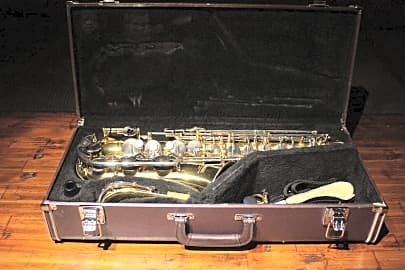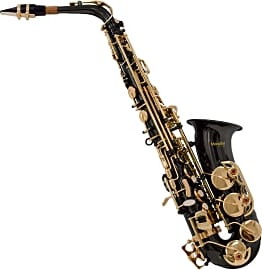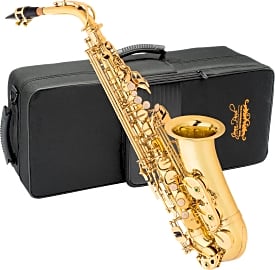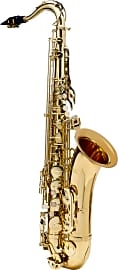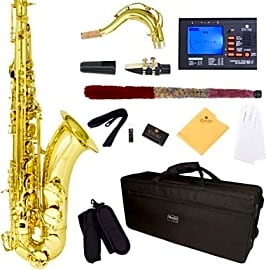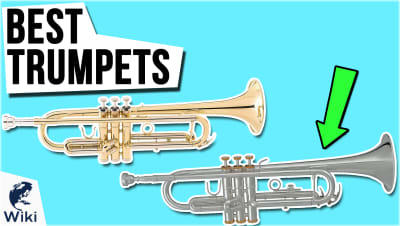The 8 Best Student Saxophones

This wiki has been updated 36 times since it was first published in October of 2016. While it is easy to spend many thousands of dollars on an instrument, it may be wiser to hold off until you are sure that you or your child will stick with it. These student saxophones are priced reasonably and designed to make it easier for beginners to learn on. We've included some models that include only the sax, and full sets that come with mouthpieces, reeds, a case, and more. When users buy our independently chosen editorial selections, we may earn commissions to help fund the Wiki.
Editor's Notes
December 30, 2019:
Saxophones are considerably more complex instruments than, say, trumpets, and tend to be relatively expensive even in the beginner's range. That doesn't mean you have to spend a fortune, though; the Jean Paul AS-400 and Mendini MAS are actually quite reasonably priced for alto saxophones, while the Jean Paul TS-400 and Mendini MTS are similarly affordable for tenors (which tend to be even more costly than altos). A lot of band directors warn derisively against purchasing "saxophone-shaped objects," but despite these units' remarkably low prices, they're actually functioning instruments that most students will have a great time learning on.
If you're not worried about the danger of a student giving up and being stuck with an unused and expensive instrument, there are some slightly more costly models definitely worth looking into. For B-flat tenor models, it's hard to beat the Selmer TS500 and Selmer Prelude TS711. Again, they're more costly than altos, and they're not usually ideal for very young players simply because of their size and the volume of air they require, but they are great instruments that don't cost nearly as much as pro models.
Alto players also have plenty of flexibility at the high end of student horns. The Yamaha YAS-280 is about as nice as you can get for less than $2,000, and if you're looking to spend less but still take home a highly durable and precision-manufactured instrument, the Yamaha YAS-23 might be right for you. It's one of the most popular as well as most frequently recommended by instructors and band directors.
Special Honors
Midwest Musical Imports Used instruments can be had for considerably less than new ones, and they're often in nearly as good of condition, too. There are a usually a handful of places to get good deals locally, and MMI has a great online repository of their available models. It's not ideal for high-end professionals to buy a horn without playing it first, but generally speaking, as long as you know what you're looking for, a used saxophone from a third-party retailer can be great for most beginners. mmimports.com
Facts About The Sax
This variation is caused not only by the musician and musical genre, but also by the fact that there are different types of saxophones.
If you’ve listened to much rock or jazz music, you may have noticed that saxophones can sound quite different; for an example, try comparing the sounds of Kenny G’s Forever In Love to the sax solo in The Rolling Stone’s Brown Sugar. This variation is caused not only by the musician and musical genre, but also by the fact that there are different types of saxophones. Kenny G’s go-to sax is the soprano, while Bobby Keys from The Rolling Stones often reached for the tenor.
Although the exact number of members in the sax family exceeds 10, perhaps hitting 20 when you take into account more unusual variants, there are four saxophones that tend to be the most common: soprano, alto, tenor, and baritone. Saxophonists usually choose one of these as their main instrument, but they may also enjoy playing on and be proficient with more than one type.
The soprano is the highest-pitched of the four most widely used saxes. A B-flat instrument, the soprano is usually straight, but curved variations are available. Because it tends to be harder to tune than the others and even somewhat more difficult to play, this is not generally the sax for beginner students. A few famous musicians with soprano skills include Branford Marsalis, Wayne Shorter, and Sam Rivers.
The alto sax, pitched in E flat, is the next largest. It’s usually considered the easiest sax to hold and features a mouthpiece that’s neither too big nor too small, factors that make it the number one choice for beginning saxophonists. David Sanborn, Art Pepper, Jimmy Dorsey, and Charlie Parker are all known for their prowess on the alto.
The next biggest, the tenor saxophone, is pitched in B flat, has a bend in its neck that is not found on the alto, and has many applications, including in rock, jazz, and military bands. You’ll find them in school marching bands and orchestras, too, with some students even starting out on the tenor. Influential tenor sax players include John Coltrane, Stan Getz, Coleman Hawkins, and Sonny Rollins.
The largest of the common saxophones is the baritone, which is pitched in E flat. Its size gives it a deep sound that’s popular with jazz musicians, but this also means that it takes quite a volume of air to play it effectively. For this reason, the “bari” tends to be for more experienced musicians. Serge Chaloff, Brian Landrus, and Pepper Adams are all famous baritone saxophonists.
Differences Between Student And Pro Saxophones
When newbie sax players take up this instrument, they often reach for student saxophones. For most, making the choice comes down to price; student instruments are designed to be less expensive than either intermediate or professional models. This way, if the student doesn’t want to continue playing the sax, then he or she hasn’t invested nearly as much money. But there are plenty of other differences between student and pro models, too.
Materials and finishes can affect how bright or warm the sax sounds, distinctions that offer more usefulness to experienced players.
For example, student saxophones tend to feature basic brass and lacquer, whereas a higher-level model might be made from a nickel-silver or bronze alloy or with a gold- or silver-plated finish. Materials and finishes can affect how bright or warm the sax sounds, distinctions that offer more usefulness to experienced players.
A student saxophone must also be hardier than a pro model, since the brand-new player may not quite understand how to best use and care for a sax. For this reason, student models feature stronger braces and more durable pads while omitting some of the styling, such as engraving, of intermediate and pro models. Think about learning to drive; would you put a student behind the wheel of a Lamborghini? Probably not, not only because of price, but because a Lamborghini is a responsive and powerful machine that requires some driving experience to handle effectively.
You’ll find, too, that student models tend to come with more accessories than pro and intermediate models. An experienced pro buying a new sax has had time to accumulate neck straps, reeds, cleaning cloths, cork grease, metronomes, and all the necessities. New students, however, don’t have these items and may not even know what extras they need, making a student model with an accessory package highly useful.
Finally, a pro-model instrument offers greater longevity than does a student model. A student sax can provide adequate playability for several years, but at a certain point, the budding musician will probably need a better instrument to make progress. A professional saxophone, then, can last for decades, even a lifetime, by supporting a player as he or she continues to grow more proficient.
A Very Brief History Of The Saxophone
Unlike music, which is as old as civilization itself, the saxophone is a relatively new invention. We can thank musician and inventor Antoine-Joseph Sax for its genesis; Sax, who was more commonly called Adolphe, patented this new instrument in 1846. Highly talented, Sax actually created a range of novel instruments he referred to generally as saxhorns and these paved the way for several modern instruments, including euphoniums and flugelhorns.
Luckily, they failed, but in the end, he filed for bankruptcy a total of three times and spent his later years in difficult health and financial circumstances.
Today, the saxophone is commonly considered a jazz or rock instrument, but Sax’s first horns were widely popular in military bands. They offered the expressive qualities of a woodwind with the power of brass instruments, an exciting development that caused quite a stir in musical circles. For a number of reasons, he was perhaps not as successful in life as he could (or should) have been. His ideas weren't fatally flawed or anything like that; in fact, the saxophone was so promising from the start that a group called the United Instrument Makers tried to assassinate him, once by bomb and once by stabbing, and steal the plans for themselves. Luckily, they failed, but in the end, he filed for bankruptcy a total of three times and spent his later years in difficult health and financial circumstances.
Despite Sax’s turbulent life and troubles, the saxophone managed to live on, mostly due to the fact that these early instruments found their way into the hands of American jazz musicians. Sometime after 1920, the popularity of the sax tipped, securing its role as an important and perhaps even necessary part of the jazz ensemble. Some experts note that jazz players took to the sax because it provided a voice-like quality, allowing the players to express themselves in ways similar to singing.


